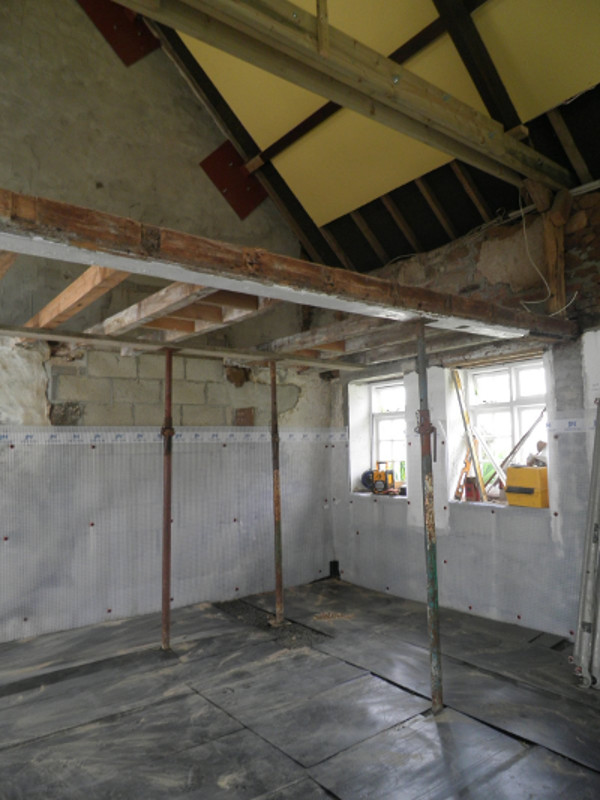20 May 2019
RJ Le Sueur Ltd was fined a total of £25,000 plus £3,000 costs by the Royal Court on Friday 26 April 2019 after pleading guilty to breaches of the Health and Safety at Work (Jersey) Law 1989 (HSW Law) and the ‘Management in Construction (Jersey) Regulations 2016’ (Construction Regs). This case represented the first prosecution under the Construction Regs since their introduction on 1 October 2016.
The prosecution followed an accident in which an employee of RJ Le Sueur sustained serious spinal injuries when he fell approximately 2.4 metres whilst helping to demolish a first floor structure during significant renovation works. The photograph below was taken by an Inspector shortly after the accident and clearly shows the lack of any measures to control the risks associated with the work. An immediate Prohibition Notice was served by the Inspector preventing any further work at height until a safe system of work had been put in place.

Figure 1: Scene of accident
On the day of the accident, two employees were instructed by a Company Director to remove the final section of floorboards and timber joists forming the first floor. No specific instructions were given on how this was to be done, but the Director subsequently commented that he had expected the employees to work from below, either using a tower scaffold or stepladders, particularly as he had discovered an employee standing on the first floor joists the previous day and told him, in no uncertain terms, that it was unsafe to be up there as the whole floor structure was rotten.
In the event, the two employees adopted the same system of work they had used to demolish the rest of the first floor, ie primarily standing on top of the floor, pulling up the floorboards which were nailed to the joists, and dropping them through the gap created. The plan was to then remove the joists from below working from stepladders.
On the day in question, the two employees were standing on the joists removing the final few floorboards when a joist suddenly snapped. Both the joist and workman fell to the ground below, with the employee landing on his back across the joist.
Comments
The accident investigation identified a number of concerns regarding the approach to the planning and management of the work being carried out. These are summarised below to help duty holders review their own working practices and ensure they are meeting the legal requirements.
Ineffective arrangements for assessing, planning and determining a safe system of work:
- risk assessments and method statements for the construction project were generic, undated and unsigned with little relevance to the real hazards and risks associated with the work. For example the risk assessment for the removal of the first floor made no reference to its poor condition, the open edge created during the sequential removal, the floorboards being nailed in place from above etc.
- the control measures set out in the method statements were generic rather than being specifically tailored to the work. For example the method statement relating to the removal of the first floor noted a range of equipment that could be used to control the risk of falls from height (ie mobile tower scaffold, trestles, stepladders) but did not specify what measures were to be adopted or the safe system of work to be followed
- there was no evidence of an assessment of the hierarchy of controls required to protect against falls from height being carried out, as required by Regulation 27 of the Construction Regulations. Instead, there was a belief that the work could (and should) have been carried out using stepladders. This failed to meet the requirements of Regulation 27 as it was reasonably practicable to provide safer collective fall protection, for example a scaffold deck (as used to complete the work after the accident), air bags etc.
Lack of control and supervision over work at height:
- the unsafe system of work used to remove the first floor at the time of the accident had been adopted throughout its removal (the floor was removed in 3 separate phases) and therefore this was not a one-off failure
- despite the high risk nature of the work and a Company Director finding an employee working on top of the rotten floor without any fall protection in place the day before the accident, the employees were simply instructed to remove the final section without any checks to ensure they knew and understood what protective measures were required, or that these had actually been put in place. Instead, there was an over reliance on experienced employees to decide how to carry out the work safely
In its Judgement the Court commented that risk assessments and method statements are an important part of ensuring the safety of employees. They should clearly identify the hazards involved in the work and set out, in simple but unambiguous terms, specifically how the work will be carried out safely.
The Court also commented that, in this instance, the employer should have recognised that it was physically easier to remove the floor from above than the below and taken sufficient steps to ensure a safe system of work was adopted, particularly when was known that employees had worked from on top of the floor and put themselves at risk previously.
The £40,000 fine requested by the Crown was reduced to £25,000 by the Court, but with a clear message that this reduction was solely due to the financial circumstances of the company.
The Court also expressed a wish to give the clearest of warnings that the Health and Safety at Work (Jersey) Law 1989 applies equally to all employers, irrespective of the size of the company, and not complying is never acceptable.
Guidance on the Construction Regulations, including safe work at height, is available.